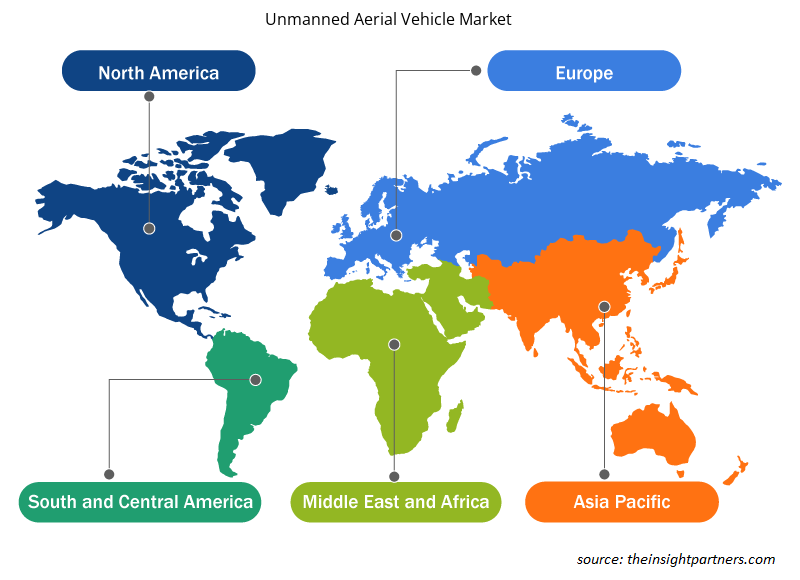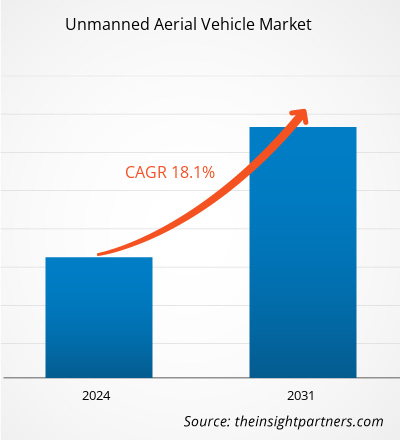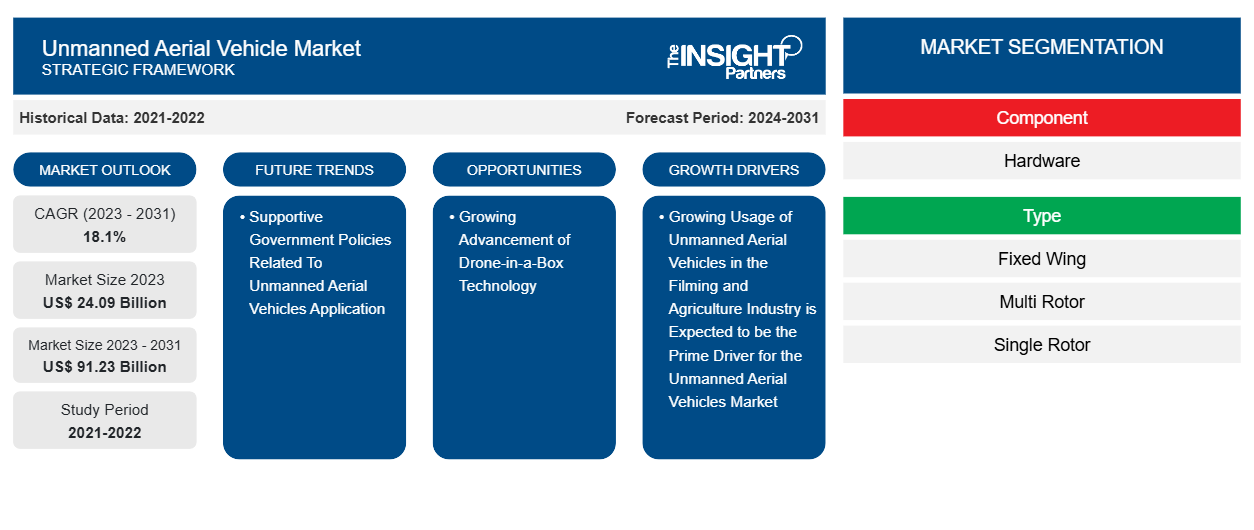Der Markt für unbemannte Luftfahrzeuge soll von 24,09 Milliarden US-Dollar im Jahr 2023 auf 91,23 Milliarden US-Dollar im Jahr 2031 anwachsen. Der Markt soll in den Jahren 2023–2031 eine durchschnittliche jährliche Wachstumsrate von 18,1 % verzeichnen. Die zunehmende Verbreitung unbemannter Luftfahrzeuge für Präzisionslandwirtschaft, Fotografie und Überwachung treibt das Wachstum des Marktes für unbemannte Luftfahrzeuge weltweit voran.
Marktanalyse für unbemannte Luftfahrzeuge
Die zunehmende Nutzung unbemannter Luftfahrzeuge in verschiedenen Endverbrauchsbranchen wie Landwirtschaft, Öl und Gas sowie Bergbau dürfte das Wachstum des Marktes für unbemannte Luftfahrzeuge auf globaler Ebene vorantreiben. Die zunehmende Verbreitung unbemannter Luftfahrzeuge im Verteidigungs- und Sicherheitssektor zur Aufnahme von Luftbildern zur Verbesserung der Maßnahmen für starke Verteidigungssysteme dürfte die Entwicklung des Marktes für unbemannte Luftfahrzeuge weltweit vorantreiben. Darüber hinaus treibt die zunehmende Nutzung unbemannter Luftfahrzeuge für Kartierung und Vermessung, Notfallsuche, Reaktion, Rettungsaufgaben, Seenotrettung und Meteorologie usw. die Weiterentwicklung des Marktes für unbemannte Luftfahrzeuge weltweit voran. KI-gesteuerte Aspekte wie autonomes Fliegen, Objektverfolgung und automatisierte Bildverarbeitung verbesserten die Fähigkeiten unbemannter Luftfahrzeuge und unterstützten neue Anwendungen, was sich positiv auf den Markt für unbemannte Luftfahrzeuge auswirkt.
Marktübersicht für unbemannte Luftfahrzeuge
Die zunehmende Verbreitung unbemannter Luftfahrzeuge zur Überwachung von Unfallsituationen wie Überschwemmungen, Erdbeben oder Bränden ist ebenfalls ein wichtiger Treiber für den Markt. Die Rettungskräfte nutzen Drohnen in erster Linie zu Überwachungs- und Beobachtungszwecken und um sich einen Überblick über die Gesamtsituation aus der Luft zu verschaffen, der ihnen bei wichtigen Entscheidungen über die Einleitung von Rettungsmaßnahmen hilft. Darüber hinaus wirkt sich die zunehmende Nutzung unbemannter Luftfahrzeuge im Öl- und Gas- sowie im Bergbausektor auch positiv auf den Markt für unbemannte Luftfahrzeuge weltweit aus. Der Markt für unbemannte Luftfahrzeuge ist nach Komponenten, Typ und Anwendung segmentiert. In Bezug auf die Komponenten ist der Markt für unbemannte Luftfahrzeuge in Hardware (Kamera, Sensoren und andere) und Software unterteilt. Auf der Grundlage des Typs ist der Markt in Starrflügel-, Mehrrotor-, Einrotor- und Hybridflugzeuge unterteilt. Darüber hinaus ist der Markt auf der Grundlage der Anwendung in Einzelhandel, Militär und Verteidigung, Medien und Unterhaltung , Privatpersonen, Landwirtschaft, Industrie, Strafverfolgung und Bauwesen segmentiert.
Passen Sie diesen Bericht Ihren Anforderungen an
Sie erhalten kostenlos individuelle Anpassungen an jedem Bericht, einschließlich Teilen dieses Berichts oder einer Analyse auf Länderebene, eines Excel-Datenpakets sowie tolle Angebote und Rabatte für Start-ups und Universitäten.
-
Holen Sie sich die wichtigsten Markttrends aus diesem Bericht.Dieses KOSTENLOSE Beispiel umfasst eine Datenanalyse von Markttrends bis hin zu Schätzungen und Prognosen.
Treiber und Chancen auf dem Markt für unbemannte Luftfahrzeuge
Wachsende Nutzung vonUnbemannte Luftfahrzeuge in der Film- und Landwirtschaftsbranche werden voraussichtlich der Haupttreiber für den Markt für unbemannte Luftfahrzeuge sein
Die wachsende Nachfrage nachUnbemannte Luftfahrzeuge für Luftaufnahmen und Videoaufnahmen in der Medien- und Unterhaltungsbranche sind einer der Haupttreiber für den Markt für unbemannte Luftfahrzeuge. Die zunehmende Verwendung von High-End-Drohnenkameras zur Aufnahme von Weitwinkel-Luftvideos und -bildern fördert auch das Wachstum des Marktes für unbemannte Luftfahrzeuge auf globaler Ebene. Die zunehmende Verbreitung der Digitalisierung und Integration von Softwareanwendungen zur Überwachung der allgemeinen Betriebseffizienz von Ackerland wird voraussichtlich das Wachstum des Marktes für unbemannte Luftfahrzeuge weltweit vorantreiben. Die Echtzeitdaten und Luftbilder des gesamten Bauernhofs helfen den Landwirten, Probleme im Zusammenhang mit dem Wohlergehen des Landes zu erkennen, die sich negativ auf die Ernteerträge auswirken könnten. Darüber hinaus ist die Bewirtschaftung mittelgroßer bis großer landwirtschaftlicher Flächen in abgelegenen Gebieten ohne den Einsatz von UAV-Kameras nicht möglich, da diese bei der Aufnahme von Luftbildern des Landes für eine bessere Betriebsführung helfen. Daher scheint die Nutzung fortschrittlicher Technologien ein wichtiger Antriebsfaktor für den Markt zu sein.
Unterstützende Regierungspolitik im Zusammenhang mit dem Einsatz unbemannter Luftfahrzeuge
Unterstützende Regierungsrichtlinien für Drohnenflüge helfen bei der Bewirtschaftung landwirtschaftlicher Flächen, der Paketzustellung am selben Tag, beim Filmen und Fotografieren sowie bei der Überwachung und Aufnahme von Bildern von Öl- und Gas- und Bergbaustandorten. Daher wird erwartet, dass die zunehmende staatliche Unterstützung und Hilfe für den Einsatz moderner unbemannter Luftfahrzeuge für Überwachung, Beobachtung und Sicherheit die Entwicklung des Marktes für unbemannte Luftfahrzeuge in den kommenden Jahren vorantreiben wird. Die zunehmenden geopolitischen Unruhen und zunehmenden kriegsähnlichen Situationen treiben den Einsatz von Kameras unbemannter Luftfahrzeuge zu Überwachungszwecken voran, was voraussichtlich die Entwicklung des Marktes im Prognosezeitraum vorantreiben wird.
Segmentierungsanalyse des Marktberichts für unbemannte Luftfahrzeuge
Wichtige Segmente, die zur Ableitung der Marktanalyse für unbemannte Luftfahrzeuge beigetragen haben, sind Komponente, Typ und Anwendung.
- Basierend auf den Komponenten wurde der Markt für unbemannte Luftfahrzeuge in Hardware (Kamera, Sensoren und andere) und Software unterteilt. Das Hardwaresegment hatte im Jahr 2023 einen größeren Marktanteil.
- In Bezug auf den Typ wurde der Markt in Starrflügel, Multirotor, Einzelrotor und Hybrid segmentiert. Die Hybridsegmente dominierten den Markt im Jahr 2023.
- In Bezug auf die Anwendung wurde der Markt in Militär und Verteidigung, Einzelhandel, Medien und Unterhaltung, Privatkunden, Landwirtschaft, Industrie, Strafverfolgung und Bauwesen segmentiert. Die Segmente Militär und Verteidigung dominierten den Markt im Jahr 2023.
Marktanteilsanalyse für unbemannte Luftfahrzeuge nach Geografie
Der geografische Umfang des Marktberichts für unbemannte Luftfahrzeuge ist hauptsächlich in fünf Regionen unterteilt: Nordamerika, Europa, Asien-Pazifik, Naher Osten und Afrika sowie Südamerika.
Nordamerika war im Jahr 2023 führend auf dem Markt für unbemannte Luftfahrzeuge. Die Region Nordamerika umfasst die USA, Kanada und Mexiko. Viele Unternehmen in der gesamten Region konzentrieren sich auf Investitionen in fortschrittliche unbemannte Luftfahrzeuge, um den modernen Anforderungen in den Bereichen Film, Fotografie, Landwirtschaft, Bauwesen, Verteidigung und Sicherheit gerecht zu werden. Daher wird geschätzt, dass der zunehmende Einsatz unbemannter Luftfahrzeuge zur Erweiterung der Präzisionslandwirtschaft zusammen mit der steigenden Nachfrage nach hochwertigen unbemannten Luftfahrzeugen für Filme und Fotografie die Entwicklung des Marktes im Prognosezeitraum in Nordamerika vorantreiben wird. Die Vermessung und Aufnahme hochwertiger Bilder sowie die Überwachung und Identifizierung von Sicherheitsproblemen sind ebenfalls einige der wichtigsten Anwendungsbereiche unbemannter Luftfahrzeuge in der Region Nordamerika, was zur Verteidigungssicherheit und zur Prozessoptimierung in den Öl- und Gas- sowie Bergbausektoren beiträgt. Eine zunehmende Zahl von Bergbau- sowie Öl- und Gasexplorations- und -produktionsaktivitäten steigert die Nachfrage nach unbemannten Luftfahrzeugen zur Erfassung, Überwachung und Aufnahme von Luftbildern der Standorte zur Verbesserung des Betriebsmanagements, was sich ebenfalls positiv auf den Markt für unbemannte Luftfahrzeuge in Nordamerika auswirkt.
Regionale Einblicke in den Markt für unbemannte Luftfahrzeuge
Die regionalen Trends und Faktoren, die den Markt für unbemannte Luftfahrzeuge im Prognosezeitraum beeinflussen, wurden von den Analysten von Insight Partners ausführlich erläutert. In diesem Abschnitt werden auch die Marktsegmente und die Geografie für unbemannte Luftfahrzeuge in Nordamerika, Europa, im asiatisch-pazifischen Raum, im Nahen Osten und Afrika sowie in Süd- und Mittelamerika erörtert.

- Holen Sie sich die regionalen spezifischen Daten für den Markt für unbemannte Luftfahrzeuge
Umfang des Marktberichts für unbemannte Luftfahrzeuge
| Berichtsattribut | Details |
|---|---|
| Marktgröße im Jahr 2023 | 24,09 Milliarden US-Dollar |
| Marktgröße bis 2031 | 91,23 Milliarden US-Dollar |
| Globale CAGR (2023 - 2031) | 18,1 % |
| Historische Daten | 2021-2022 |
| Prognosezeitraum | 2024–2031 |
| Abgedeckte Segmente |
Nach Komponente
|
| Abgedeckte Regionen und Länder |
Nordamerika
|
| Marktführer und wichtige Unternehmensprofile |
|
Marktdichte unbemannter Luftfahrzeuge: Auswirkungen auf die Geschäftsdynamik verstehen
Der Markt für unbemannte Luftfahrzeuge wächst rasant, angetrieben durch die steigende Nachfrage der Endnutzer aufgrund von Faktoren wie sich entwickelnden Verbraucherpräferenzen, technologischen Fortschritten und einem größeren Bewusstsein für die Vorteile des Produkts. Mit steigender Nachfrage erweitern Unternehmen ihr Angebot, entwickeln Innovationen, um die Bedürfnisse der Verbraucher zu erfüllen, und nutzen neue Trends, was das Marktwachstum weiter ankurbelt.
Die Marktteilnehmerdichte bezieht sich auf die Verteilung der Firmen oder Unternehmen, die in einem bestimmten Markt oder einer bestimmten Branche tätig sind. Sie gibt an, wie viele Wettbewerber (Marktteilnehmer) in einem bestimmten Marktraum im Verhältnis zu seiner Größe oder seinem gesamten Marktwert präsent sind.
Die wichtigsten auf dem Markt für unbemannte Luftfahrzeuge tätigen Unternehmen sind:
- DJI
- Parrot SA
- 3D Robotics Inc
- Yuneec International Co Ltd
- Luftware
- AeroVironment Inc
Haftungsausschluss : Die oben aufgeführten Unternehmen sind nicht in einer bestimmten Reihenfolge aufgeführt.

- Erhalten Sie einen Überblick über die wichtigsten Akteure auf dem Markt für unbemannte Luftfahrzeuge
Marktnachrichten und aktuelle Entwicklungen für unbemannte Luftfahrzeuge
Der Markt für unbemannte Luftfahrzeuge wird durch die Erhebung qualitativer und quantitativer Daten nach Primär- und Sekundärforschung bewertet, die wichtige Unternehmensveröffentlichungen, Verbandsdaten und Datenbanken umfasst. Im Folgenden finden Sie eine Liste der Entwicklungen auf dem Markt für unbemannte Luftfahrzeuge und Strategien:
- Im April 2024 brachte DJI die Drohnen Agras T50 und Agras T25 auf den Markt. (Quelle: DJI, Pressemitteilung/Unternehmenswebsite/Newsletter)
- Im April 2024 beschaffte die schwedische Verteidigungsmaterialverwaltung von Parrot SA das UAV 06 Skatan für ihre militärische Heimatschutzreserveeinheit. (Quelle: Parrot SA, Pressemitteilung/Unternehmenswebsite/Newsletter)
Marktbericht zu unbemannten Luftfahrzeugen: Abdeckung und Ergebnisse
Der Bericht „Marktgröße und Prognose für unbemannte Luftfahrzeuge (2021–2031)“ bietet eine detaillierte Analyse des Marktes, die die folgenden Bereiche abdeckt:
- Marktgröße und Prognose auf globaler, regionaler und Länderebene für alle wichtigen Marktsegmente, die im Rahmen des Projekts abgedeckt sind
- Marktdynamik wie Treiber, Beschränkungen und wichtige Chancen
- Wichtige Zukunftstrends
- Detaillierte PEST-Analyse
- Globale und regionale Marktanalyse mit wichtigen Markttrends, wichtigen Akteuren, Vorschriften und aktuellen Marktentwicklungen
- Branchenlandschaft und Wettbewerbsanalyse, einschließlich Marktkonzentration, Heatmap-Analyse, prominenten Akteuren und aktuellen Entwicklungen
- Detaillierte Firmenprofile mit SWOT-Analyse
- Historische Analyse (2 Jahre), Basisjahr, Prognose (7 Jahre) mit CAGR
- PEST- und SWOT-Analyse
- Marktgröße Wert/Volumen – Global, Regional, Land
- Branchen- und Wettbewerbslandschaft
- Excel-Datensatz
Aktuelle Berichte
Verwandte Berichte
Erfahrungsberichte
Grund zum Kauf
- Fundierte Entscheidungsfindung
- Marktdynamik verstehen
- Wettbewerbsanalyse
- Kundeneinblicke
- Marktprognosen
- Risikominimierung
- Strategische Planung
- Investitionsbegründung
- Identifizierung neuer Märkte
- Verbesserung von Marketingstrategien
- Steigerung der Betriebseffizienz
- Anpassung an regulatorische Trends























 Kostenlose Probe anfordern für - Markt für unbemannte Luftfahrzeuge
Kostenlose Probe anfordern für - Markt für unbemannte Luftfahrzeuge